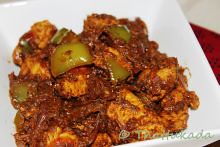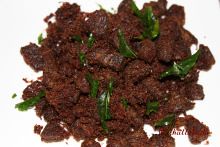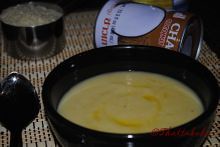Chocolate Cakes have a special place in everyone's heart. When I think of chocolate cakes, I think of Ambrosia (a Bakery in Trivandrum) whom I think has one of the best chocolate cakes and one of my friend's mom, who used to make awesome chocolate cakes. This is the kind of chocolate cake that is not too sweet with a coffee flavor and is best eaten with the plain vanilla ice cream. I have been looking for the perfect recipe for a long time and happened to see one in Bharathy's blog - Spicy Chilly. The picture looked awesome and decided to try it out. That was a wise decision and I have been making this for sometime now in different forms - cup cakes, round cakes, etc.
This time I decided to try it out with the Bundt pan that I got from CSN stores as part of a review for them. As mentioned in my prior CSN Store review, if you are looking for a specific cooking tool/gadget that you cannot find anywhere else, try CSN stores as they offer a wide range of products from twin beds to cookwares.
Now moving on to the Chocolate Bundt Cake recipe, I have made very slight changes to the measurement and here is my version:
Makes a 12" Bundt Cake
| All Purpose Flour (Maida) | - 1 cup |
| Milk Powder | - 1 tbsp (heaped) |
| Cocoa Powder | - 4 tbsp (heaped) |
| Baking Soda | - 1/2 tsp |
| Butter | - 11 tbsp (145 gms) |
| Sugar | - 1 cup |
| Egg | - 4 |
| Coffee Powder | - 1 tbsp (heaped) |
| Yogurt | - 4 tbsp |
| Vanilla Essence | - 1 tsp |
| Salt | - 1/4 tsp |
1. Sieve the Flour, Cocoa Powder, Baking Soda, Milk Powder and Salt at least 4 times to make sure that the dry ingredients are thoroughly mixed well. I used Hershey's Cocoa powder. Avoid salt if using salted butter.
2. Beat the sugar and butter well until they become smooth.
3. Add the eggs to the butter and beat well for 2-3 minutes.
4. To this, add vanilla essence and coffee powder (make sure that you are using fine coffee powder; if they are in the crystal form, powder it before you add it) and mix well.
5. Now add the yogurt to the batter and blend well. When adding the yogurt, make sure there are no lumps.
6. Now slowly fold in the flour mixture to the batter and mix well.
7. Grease a 12" bundt pan with butter and pour in the batter.
8. Bake in a preheated oven at 350 degree F for 30-35 minutes.
This cake is best eaten with a scoop of plain vanilla ice cream - yum! It is great on its own as well! Thanks Bharathy for sharing this recipe.
Sending this to "Virtual Party - Chocolaty Dreams" Event hosted by Shabitha.





























